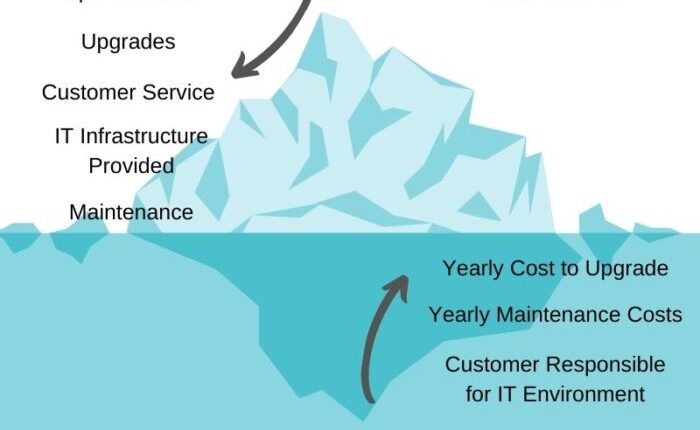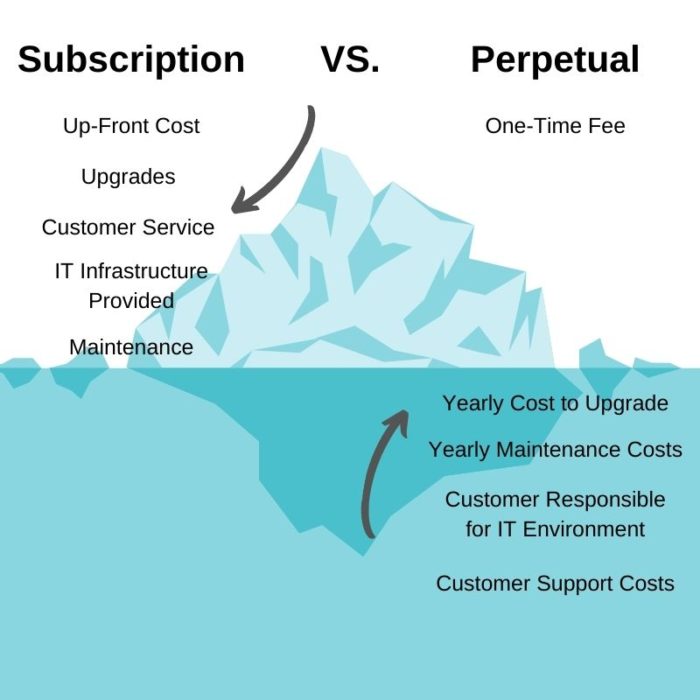
Subscription vs. perpetual software, what’s the difference? How do you decide between subscription-based software versus the traditional perpetual plan model for your company? How do you know what will be better for your company in the long run?
It’s a tough decision, especially considering a few vital points to consider before deciding between subscription vs. perpetual license.
Knowing the difference between subscription vs. perpetual license is key. Gartner predicts that “by 2020, all new entrants and 80% of historical vendors will offer subscription-based business models.”
Given that prediction, it is very likely that the perpetual license model could be obsolete within a few years. Join us as we outline why that is the case, why a subscription vs. perpetual license is different, and how to embrace and implement subscription-based software on your manufacturing floor to benefit your bottom line.
What is the Difference Between a Subscription Software and a Perpetual Software License?
The core difference between subscription vs. perpetual license is that subscription software is priced yearly or monthly and is an ongoing subscription. On the other hand, a perpetual plan license is paid up-front in one big lump sum. Then, you will typically pay a yearly maintenance fee which covers upgrades and support. Those maintenance fees usually cost 15-30% of the initial licensing cost.
It’s important to note that subscription software includes all the maintenance, upgrades, and technical support in the subscription price – no need to pay hidden fees.

An iceberg perfectly depicts the differences between the two types of software because it shows the “above water” and “below water” costs. A subscription license provides all the benefits up-front in one yearly or monthly fee – no hidden costs.
You will pay an up-front cost compared to a perpetual plan, but that often doesn’t include system upgrades, maintenance, customer support, or even an IT structure.
What are the Benefits of a Subscription Software Model?
Subscription software is often referred to by an acronym – SaaS, which means ‘Software as a Subscription.
In the subscription vs. perpetual debate, the significant benefit of a subscription software model is the ease and simplicity for you, the customer. With SaaS software, the subscription includes all servers, storage, the management of that infrastructure, and everything you need to run the software. You can implement software that can improve efficiency on the plant floor without the headache of running it yourself.
It’s cheaper to invest in a subscription software rather than a perpetual software plan because you’re sharing the infrastructure between multiple companies, effectively making subscription software cheaper in the long run.
Some people may think there is a security concern to sharing infrastructure between multiple companies. Still, SaaS software has no more risk than a perpetual subscription.
When you sign up for subscription-based software, there are several things the company is doing to ensure your safety:
- Outlining the agreed-upon conditions in a Terms of Agreement which will define the levels of access an individual will have to your data
- Consistently making updates to the software to ensure data safety and adhering to modern security standards
- Monitoring and fixing any bugs as they arise to guarantee your factory floor is kept-up-to-date and working efficiently
Subscription vs. Perpetual License: Why are People Hesitant to Leave a Perpetual Plan Subscription?
When debating subscription vs. perpetual license, most people think a perpetual software subscription is less expensive, but that isn’t the case.
Since the up-front cost of a perpetual license is often a considerable amount, people feel like they can keep the software forever, but that’s not true because eventually, you will want to upgrade or need support which is often only provided for an additional fee.
So, let’s say you pay 25% of the initial up-front costs for that yearly support and upgrades. You are essentially paying for your software again every four years.
Or, consider that you must buy a certain number of licenses up-front for each individual using the product rather than purchasing just one software for everyone. It’s often a cost many forget to factor in. Not only that but what if someone leaves and you decide not to fill the role? There is an unused license that you will not recover costs on.
The other big drawback is that? If you use perpetual software, you have to employ or have someone on contract to manage the entire software, which includes obtaining the servers, fixing any errors or bugs, etc. It’s a significant expense to operate in terms of cost and time.
Let’s say you have perpetual software, and it’s housed in an on-premise data center – who has to fix any issues or bugs as they arise? For example:
- What happens if the software is running slow?
- Or it’s running out of disk space?
- A new version of Google Chrome comes out, and it breaks the on-premise version, but you don’t have support?
- Or is an upgrade required, but suddenly, the software isn’t working?
In all these instances, fixing the problem would fall on you, the customer. But, if you were using subscription software, the software company would be there to help you resolve any issues that arise – no extra costs added.
For most SaaS software, all you need is a web browser, but if you want to run it on-premise, you would need your data center – a server, battery backup, back of the data, etc. The costs increase with on-premise software, which is why subscription-based software can be very efficient.
Why are Perpetual Subscriptions Being Phased Out?
, there is less to deal with by using SaaS software. More and more companies are finding SaaS easier to use.
Let’s use an example to drive the effectiveness of SaaS software with Xcelerator, a SaaS-based product.
Consider the speed of a product. If we find a bug in the Xcelerator software, we immediately fix the bug. As a result, it’s set for every manufacturer using Xcelerator– whether or not they had experienced the bug themselves.
Using the same example but considering perpetual software running on-premise, the on-site IT department has to receive the update and then apply it, using precious time resources that could be otherwise applied to other functions.
SaaS software is both cost and time-efficient, while perpetual licenses are outdated and time-consuming.
How Does a Subscription Model Work with Xcelerator?
As we mentioned above, Xcelerator is SaaS software. There are a few good reasons for this.
- The costs of Xcelerator are transparent. What you see is what you get – no hidden fees for maintenance or support.
- The platform runs in the cloud, and you don’t have to manage any infrastructure.
- As mentioned above, if a bug is found, we can fix the issue and fix it for everything. There is no need to provide an upgrade that requires the help of IT to implement.
- The simplicity of SaaS software gives you peace of mind and one less thing you must worry about.
Subscription vs. Perpetual License: What’s the Verdict?
We could go on and on about the benefits of a subscription-based software model, but it should be clear at this point which is the better option. With the right tools and software (ahem, subscription-based!), you can put your company on a path to a more efficient and productive plant floor.

Don’t hesitate to contact Thanh for advice on automation solutions for CAD / CAM / CAE / PLM / ERP / IT systems exclusively for SMEs.
Luu Phan Thanh (Tyler) Solutions Consultant at PLM Ecosystem Mobile +84 976 099 099
Web www.plmes.io Email tyler.luu@plmes.io
